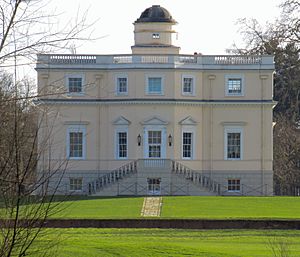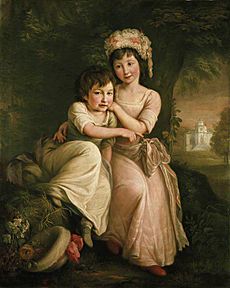King's Observatory facts for kids
Quick facts for kids The King's Observatory |
|
|---|---|
| Kew Observatory | |

The King's Observatory in winter
|
|
| Location | Old Deer Park |
| Nearest city | Richmond, London |
| Built | 1769 |
| Built for | George III of the United Kingdom |
| Original use | Astronomical and terrestrial magnetic observatory |
| Current use | Private dwelling |
| Architect | Sir William Chambers |
| Owner | Crown Estate |
|
Listed Building – Grade I
|
|
| Official name: Kew Observatory | |
| Designated | 10 January 1950 |
| Reference no. | 1357729 |
| Lua error in Module:Location_map at line 420: attempt to index field 'wikibase' (a nil value). | |
The King's Observatory is a special old building in Richmond, London. It's so important that it's a Grade I listed building. For many years, people called it the Kew Observatory.
This building was once a place where scientists studied the stars and planets. They also looked at Earth's natural magnetic field. King George III himself started this observatory. Today, it's a private home. The famous architect Sir William Chambers designed it. His design even inspired other observatories in Ireland!
Contents
Where is the King's Observatory?
The observatory and its land are inside the Royal Mid-Surrey Golf Club. This area is part of the Old Deer Park. This park used to belong to the old Richmond Palace.
The area is in Richmond, which is now part of the London Borough of Richmond upon Thames. The royal area of Kew is just north of it. You can't visit the observatory because it's private. Also, many trees hide it from view.
Who worked at the Observatory?
Many smart people worked as directors (or superintendents) at the observatory. They helped lead the scientific work there. Some of them were Stephen Demainbray, Francis Ronalds, John Welsh, Balfour Stewart, Francis John Welsh Whipple, Charles Chree, and George Clarke Simpson.
A Look Back in Time
The observatory was finished in 1769. This was just in time for King George III to watch a rare event. He observed the transit of Venus on June 3rd of that year. The building was also close to Richmond Lodge. This was where the royal family lived from 1764 to 1771.
In 1842, the building was empty. The British Association for the Advancement of Science took it over. That's when it became widely known as the Kew Observatory. Francis Ronalds was the first Honorary Director. He helped the observatory become famous for its scientific work.
Later, in 1871, the Royal Society took charge of the observatory. Then, in 1900, the National Physical Laboratory started there. From 1910, it housed the Met Office, which is the UK's weather service.
The Met Office closed the observatory in 1980. Some of its special instruments had moved earlier. The tools for studying Earth's magnetism moved in 1908. They went to Eskdalemuir Observatory in Scotland. This was because new electric systems in London caused problems for the instruments.
Cool Science Discoveries
Watching Venus Cross the Sun in 1769

King George III himself watched the transit of Venus. This is when Venus passes directly in front of the Sun. He used a special telescope for his observation.
A report from the time tells us about it. Stephen Demainbray, the observatory's leader, wrote that the King was the first to see Venus begin to touch the Sun's edge. Demainbray made sure the exact time was recorded. This was a very important astronomical event!
Amazing Self-Recording Instruments
Francis Ronalds was a brilliant inventor at Kew. He created many instruments that could record data by themselves. These were used all over the world for a long time.
In 1845, he invented some of the first successful cameras. These cameras recorded changes in things like atmospheric pressure (air pressure), temperature, and humidity. They also tracked atmospheric electricity and Earth's magnetism day and night.
His photo-barograph (a device for recording air pressure) was very important. Robert Fitzroy used it from 1862. This helped him make the UK's first official weather forecasts. The Met Office even used Ronalds' cameras until the observatory closed in 1980!
Studying Atmospheric Electricity
Ronalds also set up a clever system to study atmospheric electricity. He put a long copper rod through the observatory's dome. Special instruments called electrometers and electrographs recorded the data.
He sent this equipment to places like England, Spain, India, and the Arctic. His goal was to understand atmospheric electricity around the world. At Kew, they recorded data every two hours from 1844 to 1847.
Later, in the 1860s, Lord Kelvin installed a new system. This device could record continuously using photography. It was called the Kew electrograph. It helped scientists track potential gradient measurements until 1980. These measurements were even useful for understanding past air pollution changes!
Testing Timepieces for Accuracy
In the 1850s, the observatory started testing scientific instruments. They checked things like barometers, thermometers, and chronometers (very accurate clocks). They made sure these tools were precise. This job moved to the National Physical Laboratory in 1910.
If an instrument passed the tests, it got a "Kew Certificate." This was a sign of excellent quality.
As ships used mechanical clocks for marine navigation, accuracy became super important. Observatories like Kew, Neuchâtel Observatory, and Geneva Observatory tested these clocks. The testing process was long, often 45 days! Each clock was tested in different positions and temperatures. The rules for error were very strict.
A clock that passed these tough tests got a "Bulletin de Marche" certificate. This certificate showed how well the clock performed. These super-accurate clocks became known as Observatory Chronometers.
These tests pushed watchmakers to make more and more accurate clocks. Today's high-quality mechanical watches are very precise because of this. However, no mechanical clock could match the accuracy of a quartz movement. So, this type of testing stopped in the late 1960s and early 1970s.
What Happened Later?
In 1981, the building went back to the Crown Estate Commissioners. It returned to its original name, "King’s Observatory." In 1985, it was fixed up and turned into offices. New buildings were added too.
From 1986 to 2011, a company called Autoglass used it as their UK head office. Since 1989, Robbie Brothers of Kew Holdings Limited has held the lease.
In 1999, a landscape architect named Kim Wilkie made a plan. It aimed to connect the observatory's grounds to Kew Gardens, Syon Park, and Richmond. In 2014, the local council allowed the observatory to become a private family home. All the extra buildings have been taken down.
The Observatory in Art
There's a painting at the Ashmolean Museum of Art and Archaeology in Oxford. It's called Peter Rigaud and Mary Anne Rigaud. The painter was John Francis Rigaud. This painting shows his nephew and niece.
The picture was painted in 1778. It shows Stephen Peter Rigaud (who later became a famous mathematician and astronomer) and his older sister. They are in a park, and the observatory is in the background. Their father worked there as an observer. It's likely the park shown is Old Deer Park, where the observatory is located.


